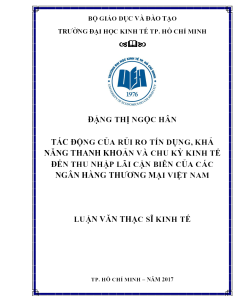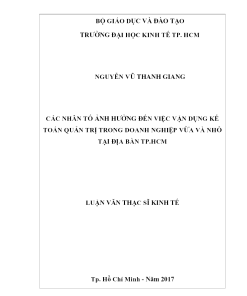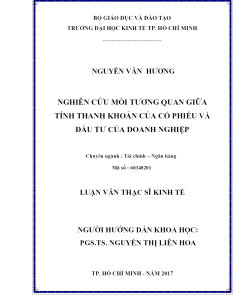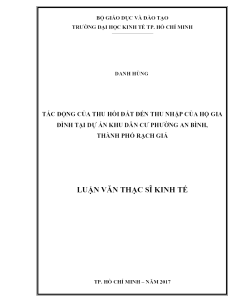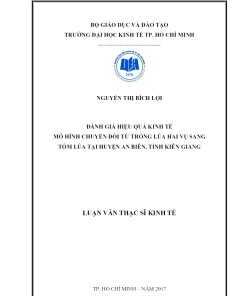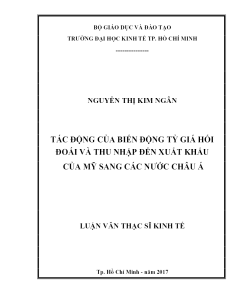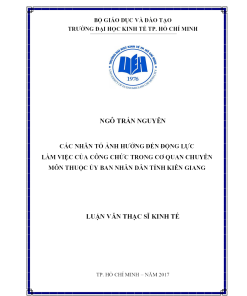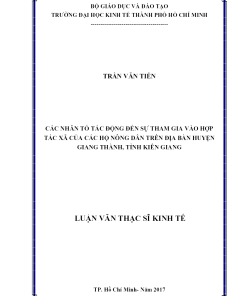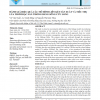- Giảm 10% phí tải tài liệu khi like và share website
- Tặng 1 bộ slide thuyết trình khi tải tài liệu
- Giảm 5% dịch vụ viết thuê luận văn thạc sĩ của Luận Văn A-Z
- Giảm 2% dịch vụ viết thuê luận án tiến sĩ của Luận Văn A-Z
Đánh giá hiệu quả các mô hình liên kết sản xuất và tiêu thụ lúa thơm đặc sản ở Đồng bằng sông Cửu Long
Giá gốc là: 20.000 VNĐ.0 VNĐGiá hiện tại là: 0 VNĐ.
Võ Văn Tuấn, Lê Cảnh Dũng và Nguyễn Thị Kim Thoa, 2020. Đánh giá hiệu quả các mô hình liên kết sản xuất và tiêu thụ lúa thơm đặc sản ở Đồng bằng sông Cửu Long. Tạp chí Khoa học Trường Đại học Cần Thơ. 56(5D): 269-277.
Assessing effectiveness of the linkage models in producing and consuming of the specialty and aromatic rice in the Mekong Delta
ABSTRACT
The study is aimed at assessing the effectiveness of the linkage models in producing and consuming of the specialty and aromatic rice based on the VietGAP standardization. It was relied on the action research approach, from rice variety selection to rice product consumption, conducted at three agricultural cooperatives in the Mekong Delta. The primary data was collected through the structured questionnaire interviews with 64 experimental members of the pilot agricultural cooperatives and 95 surrounding conventional farmers. Research results show that the linkage models based on the VietGAP standardization gained more profit than the conventional models, of which the open model has the highest net income (34.9 million VND/ha), then the semi-linkage model (24.1 million VND/ha) and the closed linkage model (17.3 million VND/ha). The “bonus price” of rice produced by the linkage models is relatively modest (+100 VND/kg); therefore, agricultural cooperatives have selected more open models in order to adapt to the context of rice production and consumption. Through the action research approach, capacity of members and managerial boards of the farm cooperatives were enhanced; and these enhancements helped them apply the standardized production codes which were used to develop contract farming and to adapt to diverse demand of qualified rice markets.
Keywords: Agricultural cooperatives, linkage models, Mekong Delta, rice, VietGAP
TÓM TẮT
Nghiên cứu này nhằm đánh giá hiệu quả các mô hình thí điểm liên kết sản xuất và tiêu thụ lúa thơm đặc sản trên nền tảng qui trình VietGAP. Nghiên cứu được tiếp cận theo “nghiên cứu hành động” từ chọn giống thích nghi đến nối kết tiêu thụ, tại ba Hợp tác xã nông nghiệp của Đồng bằng sông Cửu Long. Số liệu sơ cấp được thu thập thông qua khảo sát bằng bảng câu hỏi cấu trúc với 64 hộ thành viên trong mô hình thí điểm và 95 nông hộ bên ngoài trên cùng địa bàn sản xuất. Kết quả cho thấy mô hình thí điểm trên nền tảng VietGAP có hiệu quả tài chính cao hơn sản xuất lúa thông thường tùy vào các mức độ liên kết; trong đó, mô hình chuỗi mở có lợi nhuận cao nhất (24,9 triệu đồng/ha), kế đến là mô hình chuỗi liên kết (24,1 triệu đ/ha) và cuối cùng là mô hình chuỗi kín (17,3 triệu đồng/ha). Giá lúa tăng thêm ở các mô hình sản xuất theo hợp đồng chưa đủ lớn (+100 đồng/kg) nên các hợp tác xã có xu hướng lựa chọn mô hình ít ràng buộc hơn để thích ứng với bối cảnh sản xuất và thị trường hiện nay. Cách tiếp cận nghiên cứu hành động thúc đẩy nâng cao được năng lực của Ban quản lý và thành viên hợp tác xã, giúp họ có thể sản xuất lúa qui chuẩn, làm nền tảng phát triển các mô hình liên kết, đáp ứng đa dạng nhu cầu của thị trường lúa gạo chất lượng cao.
Từ khóa: ĐBSCL, hợp tác xã nông nghiệp, lúa gạo, mô hình liên kết, VietGAP
| Nghiên cứu khoa học | Trường đại học Cần Thơ |
|---|---|
| Tác giả | Võ Văn Tuấn, Lê Cảnh Dũng và Nguyễn Thị Kim Thoa |
| Năm | 2020 |







